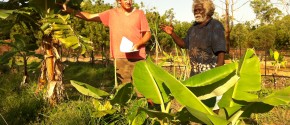As I mentioned previously, based on our nine years of work in business development with Indigenous families, I think there are four main points that define the process of rebuilding sustainable economies in remote Indigenous communities:
- A local economy grows from personal motivation and energy, it cannot be built from outside.
- Human support is required to overcome cultural and bureaucratic barriers where motivation exists.
- Production, the basis of any real economy, is driven by local ownership of local products.
- Flexibility is needed, appropriate for the pioneering and unique circumstances of remote communities.
- Subsidies are the best mechanisms of financial aid to support fledgling enterprises.
We will consider the final point in this article.
5. Appropriate Financial Aid
In remote Indigenous communities, it is not too hard to get a small loan if you really want one. Some banks and credit unions have specially designed loans for people from these communities. And many Yolngu people from east Arnhem Land have tried their hand at hire purchase arrangements. But some people still struggle with complying to the loan agreements, either not having understood what they have agreed to, or not having the real financial resources to maintain payments. These are the two fundamental problems with using loans to provide capital to business enterprises in remote Aboriginal communities. One is a communication and education problem (which other articles on our blog discuss). The other is a simple economic problem. People do not earn enough to repay initial loans for initial capital investment (see Part 2 of this series). Let’s say that someone wants to buy a four wheel drive car to start a small business. For a reliable secondhand four wheel drive it will cost them at least $10,000, plus $1,000 in travel or freight costs to collect the vehicle from a major centre and perhaps another $1,500 for some repairs in the first six months. That means $12,500 in capital is required just for the vehicle. A loan at a low interest late of 6% will mean $151 a fortnight for four years. In Part 2 we learn that a high average fortnightly income in these communities might be about $600. So the loan repayment is 25% of that person’s income over those four years. After housing rent payments this leaves him or her with only $300 a fortnight for the family. It’s all good if the entrepreneur gets a good return from the investment after the first year or two, but in the current environment with incomes subsidised by Centrelink payments and the legal requirements for award wages, most income will be absorbed in trying to pay his workers above these thresholds. Even operating in a cash economy, it is near impossible to pay workers for less than the fortnightly returns received on unemployment benefits, as workers just won’t put up with less than what they receive in unemployment benefits. Unless a person has access to royalty payments through their clan, what I have presented is a best case scenario for such a loan.
I have seen some success for low income families raising capital through interest free loans (or extremely low interest). The poor understanding of interest, means that it is not a successful incentive for repayment, so interest free loans are no less likely to be repaid. In fact where there is a good, established, relationship between the loan giver and the recipient, Aboriginal people are usually very keen to repay the debt, to protect that relationship and future access to credit. However, loan schemes beware, it is very difficult for an organisation to build the necessary relationship, and only those with a good understanding of the mainstream economy will be reliable re-payers.
By talking about loans first I may have encouraged the assumption that indigenous people do not have the ability to raise their own funds. This is not the case. I have found that this is rarely the case for small investments. Up to about $20,000 entrepreneurs can draw on the income of relatives to obtain investment capital, and sometime when royalties from land use are available they may be able to raise up to about $50,000. In order to maintain ownership and a sense of self-reliance, it is best to encourage people to use their existing assets. I do this by ensuring that the possibilities of loans and grants (an absolute last resort) are not even raised as possibilities until the person has assessed and attempted to raise their own funds. This might include helping them design a saving strategy. People really appreciate the use of automatic periodical payments to their own isolated savings account to accumulate funds. These funds then become the basis for any future investment strategies. However, often for investments over $10 -15,000 the available funds cannot be raised in the timeframe required. This is when a subsidy or loan scheme should be considered. All investments over a few thousand dollars also result in significant financial stress, because the income across the community is so low compared to the rest of Australia. Where a second hand four wheel drive ($10,000) is 20% or less of the average Australian yearly income, it is 60% or more of the average income for Indigenous people in Arnhem Land. This disparity in the relative income is the key financial factor limiting the developing of local enterprises in these remote townships and homelands.
Unlike countries like India, Australian has a single tier economy, that is, with the exception of the super rich, the goods we buy mostly target the same income levels and price range, there is a single market place, not one for richer people and one for poorer people. To continue the transport example, in India if a poorer person needs to purchase transport to take goods to market, they can buy an ox and maybe a cart, to travel to the local market. But a richer farmer can buy a motorised rikshaw or even a truck at a much higher price and this allows him to get goods to the more highly priced city markets. For low income people in Australia, such cheaper alternatives to the mainstream market do not exist – they have to buy a vehicle (even a second hand one) priced at levels that are set in the mainstream marketplace.
No one locally is going to sell a decent car for half the usual asking price to a Yolngu entrepreneur. That’s why I argue that the best financial aid for remote indigenous enterprise are subsidies. Subsidies are distinctly different from grants. Grants cover the entire or the majority of the capital investments or small business start up needs. They are usually provided by Government schemes and are essentially a bet based on business viability reports that this is a business that will succeed and bring a net return to the community. But because they are essentially a gift, they encourage the community’s prevailing welfare based view that the Government is the all powerful provider of their needs, it undermines any sense of ownership in the new asset, removing any sense of success of fulfilment which could come from reaching that investment goal. It is observed that sometimes businesses supported by grants fail because the business owners do not maintain the new asset, assuming that the Government will just give them another one. On the other hand, subsidies, which are still a gifting of finance, are provided on the basis that the entrepreneur pays the other 50 – 70% of the item’s cost. Rather than giving on the basis of a bet on later success, it should be on the recognition that the people living in this community have much less income available to them. Subsidies are more relational, because they say to the person “we believe that you can raise at least half the funds and we will give you the other half if you do”. It is a form of investment in the person, but a kind of partnership that leaves the ownership with the local visionary. In this way it is also an encouragement that says …” someone believes in me.” It is also an encouragement to save and invest, while making the task not quite so huge, people have less financial stress, and are free to make choices to increase their own investments in other areas of the business it they want to. But most importantly of all, subsidies (which should never exceed 50%) makes people still feel like they bought the item, that they own the business, and the community sees the effort the business owner puts in to invest into that car, chainsaw, computer, tractor or shed etc.
Caution is always required: the subsidising organisation or individual must be careful that the receiver is genuinely motivated to run the enterprise. Subsidies must be relational: the receiver must have some personal contact with the giver and clearly understand the agreement. At some price level (say over $20,000 or maybe $50,000) subsidies may no longer be appropriate and a partnership (dual ownership) is necessary to honour the value of the investment and the relationship that is created in supporting that persons endeavour. A partnership of course is also necessary if the investor wants to match more than 50% of the monetary capital needed. This type of partnership does not mean that the investor must take control of the enterprise to ensure it succeeds. It means ensuring that the entrepreneur is adequately supported, but still allowing some failures (which is how all entrepreneurs learn).
So in a nutshell, appropriate financial aid requires that a support structure exists to help and encourage individuals and families to save and utilise their own resources to get capital investments. Where the time is unavailable or the income is insufficient, other forms of financial support can be considered. Grants are the usually the least helpful form of aid, because they perpetuate welfare dependency and undermine the ownership in the business. I recommend 30 – 50% subsidies for individual capital purchases in recognition of the lower available incomes in most Indigenous communities relative to the mainstream economy. It also provides a relational way of helping financially and encouraging a person in their endeavour, but without undermining their sense of ownership.
To read all the articles in this series please view the learning pathway: Understanding the Economics of Remote Communities





Graeme Batterbury •
I have spent the past ten years working with a women’s empowerment programme in Bihar, one of the poorest states in India. We are focussed upon Self Help Groups (SHG) and micro-finance linkages with local banking institutions to support the development of Income Generating Activities (IGA) by the women.
Self Help Groups are the central strategy to all programes we facilitate. Briefly, Self Help Groups are groups of 10 – 15 women, from the same village and generally from the same economic strata and caste.
They are supported by our organisation to conduct fortnightly meetings where they discuss their social situation, covering such topics as domestic violence, family planning, their economic condition, local operation of government agencies and other concerns. They elect a President, Secretary and Treasurer to manage the SHG.
Each member brings a small number of rupees to each meeting, which forms a group kitty. When the kitty reaches a certain amount, they agree to lend some of that money to a group member who has a financial need, which may be sickness or injury in the family, a marriage in the family, or any other of the countless demands upon their scant resources. This is termed inter-loaning.
The group and the borrower determine the instalments, interest to be paid and the time-frame for the loan. It is in the interest of the whole SHG that the repayments are made and a combination of encouragement and peer pressure are important elements in the timely repayment.
In this way, the women learn about loans and repayment. The women are generally from the same socio-economic groupings and as such share similar experiences and interests, helping them to understand each others needs and build community and connection.
When the SHG has amassed a steady amount in the kitty, our organisation supports them to establish a savings account in a local bank. When the group has reached a specified amount, the bank will lend the SHG, as a group, an agreed amount of money. The group will then select which members are eligible for a loan with which they will start a small income generating activity ie. they might purchase a cow, or a few goats or pigs, or start a small shop or grow vegetables.
The women must repay the money and once again it is in the interest of the whole group that they successfully make the repayments. The interest rate is generally around 12%, so if each of the 12 members of the group repay their loan at 2%, then 12% goes to refurnish the loan and the other 12% goes into the group kitty. The percentage of successful repayments world-wide amongst women in this type of group is in the high 90’s! (The repayment rate for men is in the mid-40’s).
Many of the women in the groups are on their third or fourth loans.
A number of important factors in this system are:
• the group members are taught and practice the principles of loaning and repayment before receiving any substantial loan,
• the loans are initially given to the group, not just to an individual,
• peer pressure and encouragement assist members to make timely repayments
• the amount of the loans will increase incrementally, starting at a manageable level and increasing as the members gain experience and success.
The fact that the capital required for most enterprises in Australia is generally considerable and the repayments therefore relatively high, means that risk factors are greater and appropriate support mechanisms MUST be an integral part of any entrepreneurial initiative.
There have been many models developed across the world, with varying degrees of success, but most importantly any local initiative must fully address local circumstances.